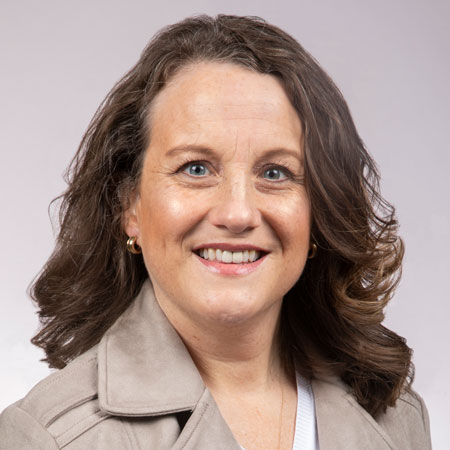News & Announcements
Perspectives in Respiratory Therapy: Jennifer Keely
May 6, 2020
Perspectives in Respiratory Therapy: Jennifer Keely
The COVID-19 pandemic has dominated the news cycle for months. As a respiratory therapist for 19 years and educator for 12 of those years, Jennifer Keely has followed these stories with great interest — and sometimes disappointment.
“In recent articles, respiratory therapists have been incorrectly referred to as technicians or nurses with a specialty in pulmonary care,” says Keely, BHS ’01, M Ed ’12. “Respiratory therapists are board-certified clinicians whose college education specialized in treating disorders of the cardiopulmonary system.”
The profession has come a long way since its inception in 1946, following technological advancements in oxygen delivery methods to World War II pilots. “The main requirement for our predecessors, known as ‘oxygen orderlies,’ was that they were strong enough to move big oxygen tanks around the hospital,” Keely says.
Today, respiratory therapists must have college degrees and pass credentialing examinations, and that’s where Keely, who holes RRT and RRT-AACS credentials, comes in. As an associate clinical professor in the MU School of Health Professions, Keely has taught many respiratory therapists who are on the front lines of the coronavirus pandemic. She is also using the disease to facilitate discussion with current students.
“Respiratory therapy has gotten more national publicity in recent weeks, which is refreshing for a profession that is unknown to so many,” Keely says. “We are hopeful that this will make more people aware of respiratory therapists and what we do.”
Professor Keely took time to answer several questions about respiratory therapy, and her responses are below.
Read our other Perspectives in Respiratory Therapy stories.

Professor Keely poses with students on their first clinical day in 2017. From left are Alicia Smith, Moosa Almalki, Jennifer Keely, Sam Savis and Antonia Reek.
How is COVID-19 affecting your classes?
COVID-19 has had a tremendous impact, at least in the short term, on our program because of the effect it has had on students’ clinical rotations. Working with real patients in the clinical setting is where the deepest, most impactful learning happens. Since clinical learning has been suspended for students of all health disciplines for the last several weeks, students are significantly behind on clinical hours.
Since the pulmonary impact of COVID-19 is so severe, it presents many opportunities for discussion and relevant application of the ventilator strategies that I teach in class. I have tried to be very intentional, though, and not let this morph into a class that is only about this disease. There are plenty of other disease processes that can necessitate mechanical ventilation. It’s important to keep talking about those, too, for educational purposes as well as for mental and emotional reasons.
Can you explain what is happening with COVID-19 patients?
Patients with COVID-19 who require mechanical ventilation develop Acute Respiratory Distress Syndrome (ARDS), a condition that causes lungs to become very stiff and heavy. While respiratory therapists are accustomed to managing patients with ARDS, the speed and intensity with which they develop it has been alarming. Treatment strategies focus on ensuring patients’ organs receive sufficient oxygen while using ventilator settings that are gentle enough to avoid further damage to the lungs. Respiratory therapists are trained to recognize when standard settings are not appropriate and can employ ventilation strategies that are less conventional and, therefore, less familiar to non-RT clinicians.

Lydia Delcourt, left, holds her first successful arterial blood gas (ABG) test, with Jennifer Keely, associate clinical professor in the MU School of Health Professions.
What should prospective students considering respiratory therapy know?
If the prospect of a fast-paced work environment with critically ill patients interests you, consider RT. If the prospect of specializing in the cardiopulmonary system and managing life-supporting ventilators interests you, consider RT. We don’t have the high profile of some of the other health professions, but our role is critical. If the patient isn’t breathing, nothing else really matters, does it?
How has the field of respiratory therapy changed over the years?
As with nursing, our minimum degree requirement is an associate’s degree. However, in the last two decades, respiratory therapy management strategies and equipment have become increasingly complicated. All new RT programs [must now] offer a minimum of a bachelor’s degree. Increasing numbers of programs are also offering master’s degrees in respiratory therapy to prepare clinicians to become researchers, hospital and college educators, and administrators. There is also a move to develop the Advanced Practice Respiratory Therapist (APRT) credential to allow RTs to function as physician extenders, like nurse practitioners or physician assistants, but with a pulmonary focus.
What other trends are you seeing in the profession?
In some hospitals, RTs have less autonomy, and the decisions about aerosolized medications and mechanical ventilator settings are made by physicians. However, this is an old model that is rapidly changing as more physicians recognize that the clinicians who are at the bedside for 12 hours at a time can assess and treat patients more effectively and efficiently. Increasingly, RTs function quite autonomously with regard to breathing treatments, airway clearance, lung expansion therapy, and ventilator management, with the approval of the physicians who can focus their attention elsewhere.
Watch: Professor Keely talks about the most rewarding moments of respiratory therapy in the following video.
Featured in this post
